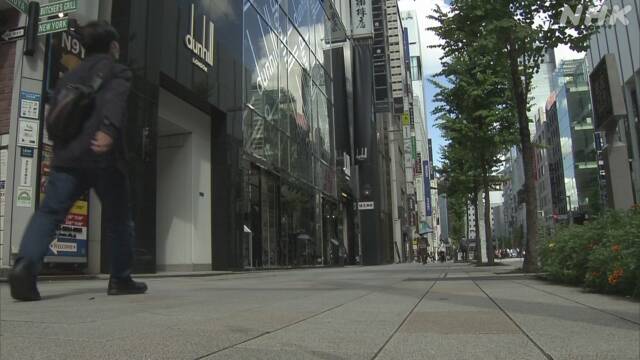Land price survey Commercial land nationwide declines Residential land in Tokyo's 23 wards rises September 29, 16:50
This year's prefectural land price survey was announced, and the average of commercial land nationwide fell for the first time in five years due to the effects of the new coronavirus.
On the other hand, demand for detached houses, which are convenient for commuting and teleworking, increased in residential areas in the 23 wards of Tokyo.
The "Prefectural Land Price Survey" is a compilation of surveys conducted by prefectures as of July 1st by the Ministry of Land, Infrastructure, Transport and Tourism, and covers more than 21,500 locations nationwide.
According to this, the average price of land nationwide, including "residential areas," "commercial areas," and "industrial areas," fell 0.6% from last year, turning to a decline for the first time in three years.
Looking at the breakdown,
▽ "Commercial land" turned to a decline of minus 0.3% on a national average for the first time in five years.
Of these, in the "regional" commercial areas excluding the three major metropolitan areas of Tokyo, Osaka, and Nagoya, demand for hotels and stores increased against the backdrop of an increase in foreign tourists, and last year, it began to rise for the first time in 28 years. However, due to the influence of the new corona virus, this was minus 0.6%.
▽ "Residential areas" fell by 0.7% on a national average, up from minus 0.1% last year.
“Three major metropolitan areas” averaged minus 0.3%, the first decline in seven years, and
“regional” averaged minus 0.9%, an increase from last year's minus 0.5%.
However, in the 23 wards of Tokyo, the increase was 1.4%, and it seems that the background to this is the increasing demand for detached houses that are close to the company and can also handle telework.
▽ "Industrial land" increased by 0.2% on a national average for the third consecutive year.
This is because the demand for large-scale logistics facilities is increasing as the use of online shopping is expanding due to the so-called "nest-going" consumption that accompanies refraining from going out. It is a factor of increase in regions and uses.
Major ascent points nationwide
For all uses, the regions of Okinawa and Hokkaido ranked high in the rate of increase.
Despite being affected by the new coronavirus, land prices are rising due to steady demand expected due to domestic tourism and urban redevelopment.
[Commercial land]
The highest rate of increase in commercial land nationwide was in Hirara, Miyakojima City, Okinawa Prefecture, where it increased by 38.9%.
Demand for stores and hotels is increasing against the backdrop of an increase in tourists and construction workers.
Second place was Maejima, Naha City, up 34.8%.
Since the land price is cheaper than other points in Naha City, there is demand for hotels, etc., and the rate of increase is increasing compared to last year.
Third place was Kita 1 Jonishi, Kutchan-cho, Hokkaido, up 32%.
In the "Niseko district" of the world-famous ski resort, there are expectations for improved convenience due to the extension of the Hokkaido Shinkansen, etc., and it is rising.
[Residential area]
The highest rate of increase in residential areas was in Gusukube, Miyakojima City, Okinawa Prefecture, where it increased by 37.3%.
Housing demand continues from hotel employees and construction personnel.
Second place was Nishizaki-cho, Itoman City, Okinawa Prefecture, up 37.3%.
Demand for housing is increasing due to good transportation access to Naha City, and it has been rising for eight consecutive years.
Third place was Kabayama, Kutchan-cho, Hokkaido, up 29.2%.
Many foreigners are moving in, and the price is rising due to demand for residential land from people involved in the tourism and construction industries.
Kutchan Town also had the third highest rate of increase in commercial areas.
[Industrial area]
The highest rate of increase in industrial areas was in Tomigusuku City, Okinawa Prefecture, where it increased by 28.9%.
With good access to Naha city and Naha airport, demand for logistics facilities is strong, and land prices are rising.
Highest price point in Japan
[Commercial Land]
The highest land price among commercial land in Japan was the "Meijiya Ginza Building" in Ginza 2-chome, Chuo-ku, Tokyo for 15 consecutive years, at 41 million yen per square meter.
Facing Chuo-dori in Ginza, where high-end brand stores are lined up, land prices fell by 5.1% for the first time in nine years, while the number of foreign tourists and other visitors decreased significantly due to the impact of the new coronavirus. ..
[Residential area]
The highest land price in a residential area was 1-chome, Akasaka, Minato-ku, Tokyo, at 4.72 million yen per square meter.
Convenience is increasing due to the redevelopment of the surrounding Toranomon area and the opening of a new station within walking distance.
[Industrial land]
The highest land price in the industrial land was Konan 5-chome, Minato-ku, Tokyo, at 564,000 yen per square meter.
Due to its good access to highways and ports, demand for logistics facilities is high and rising.

